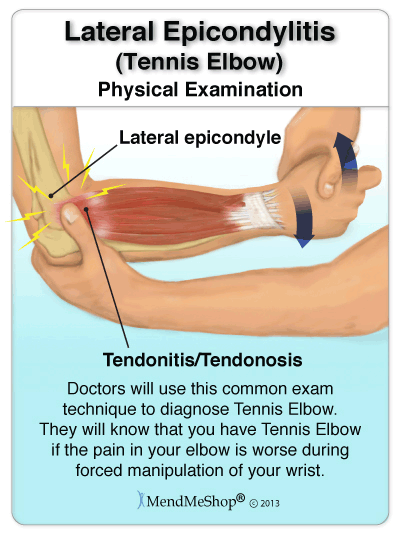Tennis Elbow/Lateral Epicondylitis
Tennis Elbow/Lateral Epicondylitis” is a common term for a condition caused by overuse of arm, forearm, and hand muscles that results in elbow Pain.
You don’t have to play tennis to get this, but the term came into use because it can be a significant problem for some tennis players.
Tennis elbow is caused by either abrupt or subtle injury of the muscle and tendon area around the outside of the elbow. Tennis elbow specifically involves the area where the muscles and tendons of the forearm attach to the outside bony area (called the lateral epicondyle) of the elbow. Your doctor may call this condition lateral epicondylitis. Another common term, “golfer’s elbow,” refers to the same process occurring on the inside of the elbow — what your doctor may call medial epicondylitis. Overuse injury can also affect the back or posterior part of the elbow as well.
Tennis elbow most commonly affects people in their dominant arm (that is, a right-handed person would experience pain in the right arm), but it can also occur in the non-dominant arm or both arms.
Who Gets Tennis Elbow?
Tennis elbow affects 1% to 3% of the population overall and as many as 50% of tennis players during their careers. Less than 5% of all tennis elbow diagnoses are related to actually playing tennis.
Tennis elbow affects men more than women. It most often affects people between the ages of 30 and 50, although people of any age can be affected.
Although tennis elbow commonly affects tennis players, it also affects other athletes and people who participate in leisure or work activities that require repetitive arm, elbow, wrist, and hand movement, especially while tightly gripping something. Examples include golfers, baseball players, bowlers, gardeners or landscapers, house or office cleaners (because of vacuuming, sweeping, and scrubbing), carpenters, mechanics, and assembly-line workers.
Treatment
The one thing people hate to hear is that have to rest an injury. We don’t encourage rest when we treat this condition with Shockwave Therapy, normally 3-4 sessions over a space of 6 weeks will cure your condition.

